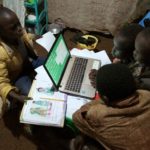Introduction
Historical records reveal that Kenyans had access to education as far back as 1728 with Swahili manuscript Utendi wa Tambuka (Book of Heraclius) attesting to this fact. The CMS missionaries interacted with locals in the coastal town of Mombasa and set up one of the earliest mission schools in the country at Rabai in 1846. Before independence, elementary education was based on the colonial system of education.
7-4-2-3 CURRICULUM
Since independence in 1963, a number of structures have been developed to guide the education system in Kenya. From 1964 to 1985 the 7-4-2-3 system of education was introduced which involved seven years of primary education, four years of lower secondary, two years of upper secondary and three years of university. The curriculum lasted for 20 years. This system of education was adopted by three East African countries, Kenya, Uganda and Tanzania as single system. This system consisted of seven years of primary education, 4 years of secondary education, 2 years of high school and 3-5 years of university education.
With the collapse of the East African Community in 1977, Kenya continued with the system of education until 1985 when the 8-4-4 system was introduced.
Implication of 7-4-2-3 system of education
7-4-2-3 system of education lacked the capacity and flexibility to respond to the changing aspirations of individual Kenyans and the labor market needs, in terms of new skills, new technologies and the attitude to work (Owino, 1997).
According to Simuyu (2001), the 7-4-2-3 policy was criticized in two major areas;
- The policy was being too academic and therefore not suitable for direct employment. Thus the policy lacked orientation to employment.
- The policy encouraged elitist and individualistic attitudes among school leavers, something that was considered incompatible to the African socialist milieu.
According to Gachathi Report (GoK, 1976, P 33-34) raised the issue of unemployment in relation to 7-4-2-3 policy: the report maintained that “one of the largest problems confronting the country is that of unemployment. The problem is aggravated by the annual outputs of school leavers whose nu,ber continue to swell following the enormous expansion of education.
Among those who made calls for change of educational policy were, the Kenya National Assembly’s Select Committee on unemployment (1970) as cited in Maleche (1976, p.13). therefore education which was regarded by Kenyans as a medium for social mobility and national economic development failed to deliver as the number of unemployed school leavers continued to grow in the first years of independence. The change consisted of increasing the technical and vocational aspects of the curriculum. This move towards vocationalising the education system won support from the World Bank.
8-4-4 Education System
The 8-4-4 system of education was introduced in January 1985, following the MacKay report of 1982. King and McGrath (2002) claims that the 8-4-4 policy arose out of the concerns that a basic academic education might lack the necessary content to promote widespread sustainable (self) employement. Threfore the 8-4-4 system was introduced with assumptions that it would equip pupils with employable skills thereby enabling school dropouts at all levels to be either self-employed or secure employment in the informal sector. King and McGrath, 2002 observes that the new policy would orient youths towards self-employment. The system strongly emphasizes attitudes and skills preparations for the world of work and especially self-employment.
According to Sifuna (1990), there are three events that led to implementation of 8-4-4 system; the 1996 conference on education at Kerich in Kenya, which stressed the need for intergration rural development; the International Labour Organization mission report entitled “Employed, Incomes and Equality: A strategy for increasing Productive Employment of 1972; “ and the recommendation of the National Committee on Educational Objectives and Policies of 1975. In 1979 the Ministry of Education was changed to the Ministry of Basic Education with an introductory nine-year basic education system program. The rationale was that the previous program was too short and not rigorous enough to give graduates enough practical education. It also recommended that the first six years of primary were to concentrate on numeric and literacy skills and the last two years on basic education with practical orientation. This represented a shift from focus on enrollment to restructuring the program as a means to cater to the influx of unemployed.
The structure of 8-4-4
The 8-4-4 is divided into primary, secondary and university excluding the pre-school years.
- Primary Education
It starts at age of six years and consists of years of schooling, out of which first three may be taught in mother tongue, while English and Kiswahili is the language of instructions from standards 4 to 8. Most schools are public and run on the basis of harambee system, but the number of private schools, is rising very fast, although the number is still small. The primary schools ends with an exam for Kenya Certificate of Primary education. Primary education is partially free which make it reasonable by third world standards in terms of enrollment level.
- Secondary education
Secondary schools consists of four years. Majority of secondary schools are run on the Harambee system. About one fourth are Government schools. The private schools charge high school fees and many offer British O-level, followed by A-levels or international Baccalaureate. The enrollment in secondary is far less compared to the primary school, as it not free. Day secondary schools are partially free and cheap to enroll although they are expensive to most Kenyans.
- University and college Education.
Since the establishment of University of Nairobi in 1970, the first public university in Kenya, seven more general public universities and an estimated number of 17 private universities followed most of them run by religious organizations. Today there are 31 public universities and still the number of enrollment is still very small.
Implications of 8-4-4 system of education
Although the 8-4-4 policy has been described a major educational reform in the history of Kenya’s education system since independence in 1963, there are views that it is great devastation. For instance, Amutabi (2003, p.136) states that:
The 8-4-4 system of education introduced in 1985 still remain the most radical and perhaps mindless change in the education in Kenya since independence. It has already caused a great devastation to Kenya that even if it were changed today, the toll on the nation will be felt for many years to come. Its devastion is similar to that of the failed Ujamaa in Tanzania many years after it was officially scrapped.
This system has been criticized for being broad, expensive and burdensome to pupils and parents. The new education policy has also been implicated in the worst strikes that engulfed a number of schools in Kenya during the year 2001 and the general poor quality of education(Amutabi, 2003).
Since its inception, 8-4-4 system has been changed to be more accommodative. Several commission have been formed with the view of improving the system. The Wanjigi Report (Gok, 1983); the Kamunge Report (GoK, 1999). A majority of these reports were either rejected or partially implemented. For instance (Muya, 2000): the Kamunge Report (GoK, 1985) ON Education and training which recommended the reduction of examination subjects under the 8-4-4, was implemented in secondary schools but ignored at the primary schools level; the president (Moi) rejected the Koech Report.
Despite the transition of Kenya’s education systems from colonially inclined theoretical education system of 7-4-2-3 to practical oriented 8-4-4 system, there are still evident gaps in the country’s education systems. The noble goal of making 8-4-4 education system skill based got lost along the way. The new educational system, 2-6-3-3 might be solution, however, it has its own challenges.
Competency Based Curriculum
In 2017, the ministry of education launched the Competency Based Curriculum (CBC), this curriculum is replacing 8-4-4 and mean to reshape education in Kenya. The CBC is designed to emphasize the significance of developing skills and knowledge and also applying those competencies to real-life situations.
The creators of the competency-based curriculum envision that at the end of the learning period, every learner should have achieved the following competencies
- Communication and collaboration
- Critical thinking and problem solving
- Imagination and creativity
- Citizenship
- Learning to learn
- Self-efficacy
- Digital literacy
CBC is divided into three levels
- Early years education
- Middle school education
- Senior school
In CBC, classes are called grades, ECD has two levels only (pre- primary 1 and 2) that is PP1 and PP2 , SBJECT AREAS ARE NOW REOFFERD TO AS LEARNING AREAS, topics/ sub-topics are now known as strands/sub-strands, learning outcomes is the new term that replaces lesson objectives, learning resources are used instead of teaching aids.
- The study period in higher learning institutions like university varies depending on the course you are doing.
- Senior school comprises three years of education targeted learners in the age bracket of 15 to 17 years and lays the foundation for further education and training at the tertiary level and the world of work.
- Junior secondary start from grades 7, 8 and 9
- Upper primary is middle school which is three years program, grades 4, 5 and 6.
- Lower primary school is grades 1, 2 and 3.
- Pre-primary is divided into pre-primary 1 and 2.
Implications of CBC
CBC is very demanding in terms of technology, this is the main challenge to learners, parents and teachers which is still favoring the able parents and schools neglecting poor pupils and schools, especially on the accessibility of power grids and internet.











